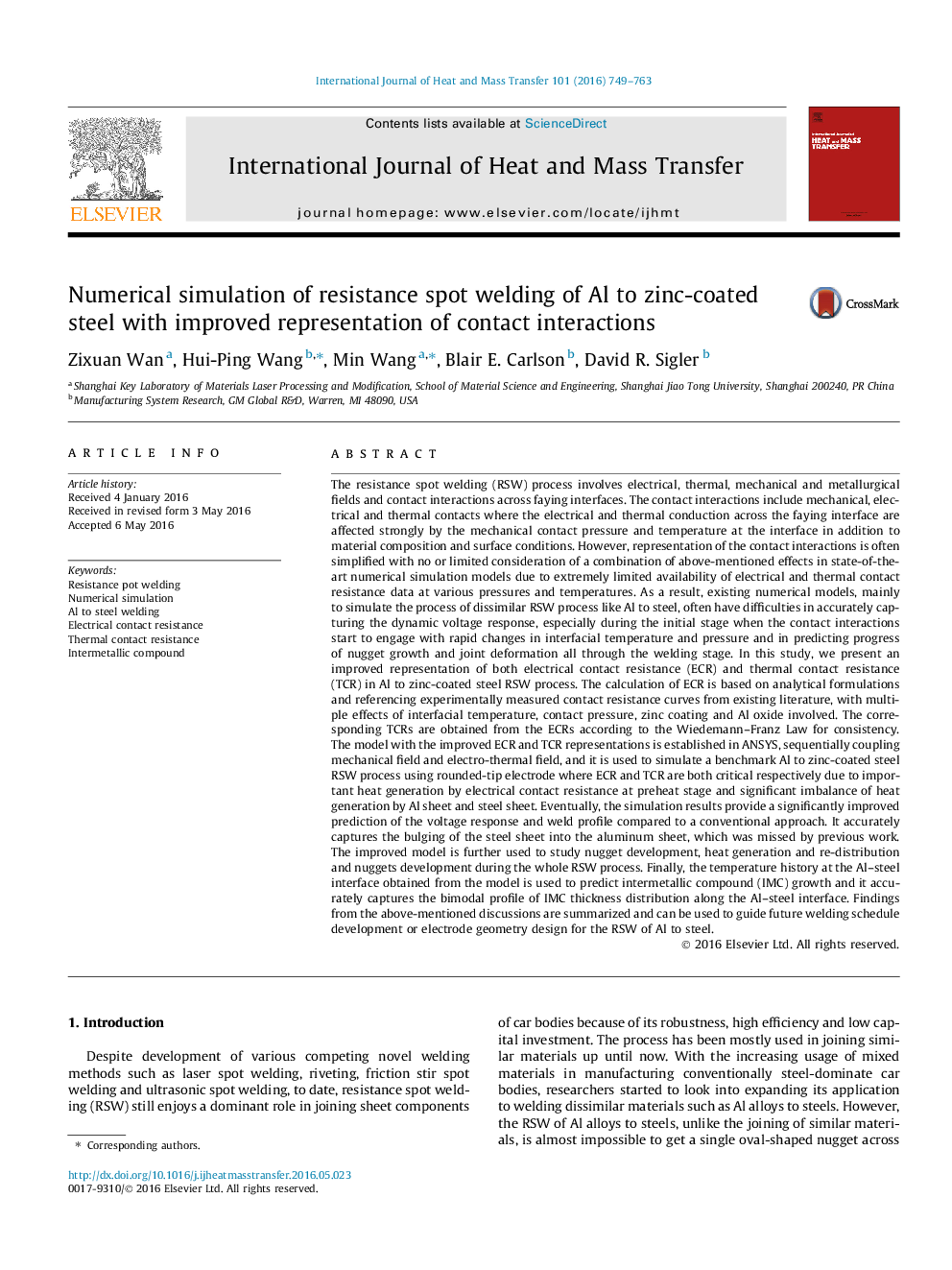| کد مقاله | کد نشریه | سال انتشار | مقاله انگلیسی | نسخه تمام متن |
|---|---|---|---|---|
| 7055380 | 1458041 | 2016 | 15 صفحه PDF | دانلود رایگان |
عنوان انگلیسی مقاله ISI
Numerical simulation of resistance spot welding of Al to zinc-coated steel with improved representation of contact interactions
ترجمه فارسی عنوان
شبیه سازی عددی مقاومت به نقطه جوش آلومینیوم به فولاد گالوانیزه با بهبود نمایندگی از تعاملات تماس
دانلود مقاله + سفارش ترجمه
دانلود مقاله ISI انگلیسی
رایگان برای ایرانیان
کلمات کلیدی
جوشکاری مقاوم در برابر جوش، شبیه سازی عددی، آلومینیوم به جوشکاری فولاد، مقاومت الکتریکی، مقاومت در برابر حرارت، ترکیبات متالیک،
موضوعات مرتبط
مهندسی و علوم پایه
مهندسی شیمی
جریان سیال و فرایندهای انتقال
چکیده انگلیسی
The resistance spot welding (RSW) process involves electrical, thermal, mechanical and metallurgical fields and contact interactions across faying interfaces. The contact interactions include mechanical, electrical and thermal contacts where the electrical and thermal conduction across the faying interface are affected strongly by the mechanical contact pressure and temperature at the interface in addition to material composition and surface conditions. However, representation of the contact interactions is often simplified with no or limited consideration of a combination of above-mentioned effects in state-of-the-art numerical simulation models due to extremely limited availability of electrical and thermal contact resistance data at various pressures and temperatures. As a result, existing numerical models, mainly to simulate the process of dissimilar RSW process like Al to steel, often have difficulties in accurately capturing the dynamic voltage response, especially during the initial stage when the contact interactions start to engage with rapid changes in interfacial temperature and pressure and in predicting progress of nugget growth and joint deformation all through the welding stage. In this study, we present an improved representation of both electrical contact resistance (ECR) and thermal contact resistance (TCR) in Al to zinc-coated steel RSW process. The calculation of ECR is based on analytical formulations and referencing experimentally measured contact resistance curves from existing literature, with multiple effects of interfacial temperature, contact pressure, zinc coating and Al oxide involved. The corresponding TCRs are obtained from the ECRs according to the Wiedemann-Franz Law for consistency. The model with the improved ECR and TCR representations is established in ANSYS, sequentially coupling mechanical field and electro-thermal field, and it is used to simulate a benchmark Al to zinc-coated steel RSW process using rounded-tip electrode where ECR and TCR are both critical respectively due to important heat generation by electrical contact resistance at preheat stage and significant imbalance of heat generation by Al sheet and steel sheet. Eventually, the simulation results provide a significantly improved prediction of the voltage response and weld profile compared to a conventional approach. It accurately captures the bulging of the steel sheet into the aluminum sheet, which was missed by previous work. The improved model is further used to study nugget development, heat generation and re-distribution and nuggets development during the whole RSW process. Finally, the temperature history at the Al-steel interface obtained from the model is used to predict intermetallic compound (IMC) growth and it accurately captures the bimodal profile of IMC thickness distribution along the Al-steel interface. Findings from the above-mentioned discussions are summarized and can be used to guide future welding schedule development or electrode geometry design for the RSW of Al to steel.
ناشر
Database: Elsevier - ScienceDirect (ساینس دایرکت)
Journal: International Journal of Heat and Mass Transfer - Volume 101, October 2016, Pages 749-763
Journal: International Journal of Heat and Mass Transfer - Volume 101, October 2016, Pages 749-763
نویسندگان
Zixuan Wan, Hui-Ping Wang, Min Wang, Blair E. Carlson, David R. Sigler,
